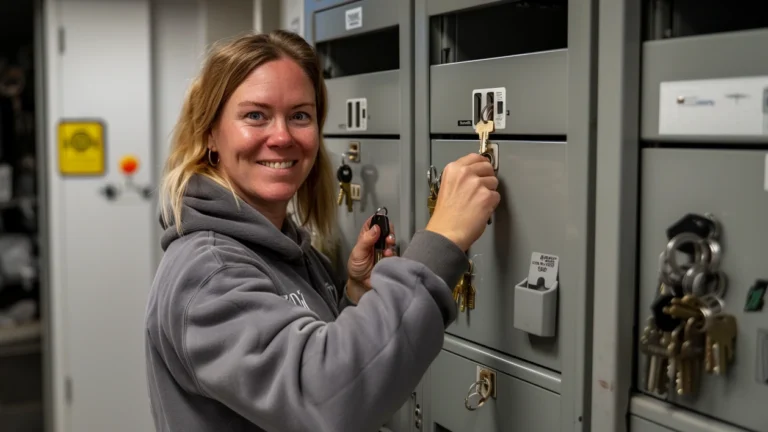In our article, you can find out how ÖNORM B1300 shapes building safety and what liability consequences it has for owners.
We explain the requirements for carrying out ÖNORM B1300 inspections and provide you with the checklist for download.
You will also learn about tools for carrying out property security checks efficiently.
ÖNORM B1300: Origin and definition
Parking lots, escape routes, stairwells, fire alarm systems, electrical installations and other technical systems
Facility management
owners are responsible for monitoring the condition of the building.
For this reason, they have to organize extensive security checks on a regular basis. To ensure optimal operation of the systems, facility managers and specialists are assigned various maintenance tasks.
maintenance tasks
entrusted with various maintenance tasks.
An ÖNORM is an Austrian standard for technical standards.
ÖNORM standards are published by
Austrian Standards International
and published by Austrian Standards International. They cover various areas such as construction, engineering, safety and quality management.
ÖNORM B 1300 was introduced in November 2012 and aims to promote the standardization of these safety tests in order to create a basis for the early detection of potential hazards. With ÖNORM B 1300 and ÖNORM B 1301, you are implementing your
operator responsibility
properly.
ÖNORM B 1300 offers building owners and their administrations a practice-oriented and structured guide to the proper fulfillment of the various inspection obligations in the area of
building management
.
What does ÖNORM B1300 contain?

ÖNORM B1300 describes routine inspection tasks that contribute to the visual inspection and assessment of buildings. These tasks are divided into 4 specialist areas:
- “Hazard prevention and fire protection”: All measures relating to the
fire safety inspections
and potential hazards such as gas leaks or weather conditions around the building. Examples of this are the maintenance of
smoke detectors
fire extinguishers or lightning protection systems. - “Health and environmental protection”: maintaining healthy (living) conditions in buildings and environmental protection measures. This includes hygiene measures such as checking ventilation systems, drinking water and disinfecting bathrooms.
- “Burglary protection and protection against external hazards”: All measures relating to burglary and access protection, civil defense and protection against natural hazards. These include access control systems such as secure key management and garage doors.
- “Technical building security”: This category refers to security measures to protect the building structure, such as the roof, façade and cornices.
Is ÖNORM B1300 mandatory?

As a standard, the application of the ÖNORM is in principle voluntary. However, building owners are obliged to monitor the condition of their building.
Pursuant to § 129 para. 2 of the Vienna Building Code, owners must ensure that their buildings remain in a good condition that meets the requirements of the building permit and the building regulations.
Pursuant to § 129 para. 5, owners were already obliged in the past to monitor the condition of their buildings and to seek the advice of an expert in the event of a suspected building defect. However, such measures have not yet had to be documented or proven to the building authorities.
In recent years, however, there has been a clear shift in facility management towards stricter procedures and increased documentation.
As a result, the 2014 amendment to the building regulations
maintenance measures
relating to safety have become subject to documentation.
§ Section 128a led to the introduction of regular inspections of building components such as supporting structures, facades, roofs, railings and balustrades. The results of these inspections must be documented in a building logbook.
If a building owner neglects their inspection and maintenance obligations and causes damage as a result, they can be held liable under civil law. This applies, for example, to damage caused by unsafe stairs, defective elevators or falling parts of the roof.
Important to note:
The owner is liable not only in accordance with the building regulations, but also based on the current condition of the building.
In order to be exempted from potential liability, the building owner must provide thorough documentation to prove that he has taken all necessary precautions to avert danger. ÖNORM inspections are particularly useful for this purpose.
If a defect is not recognizable during the usual safety checks and inspections of the building and the damage was therefore not foreseeable, the building owner is not liable.
Although ÖNORM B 1300 is currently not mandatory, it will probably also be taken into account in civil law jurisdiction in the future and serve as a guideline for the client’s duty of care.
In order to minimize the risk of potential civil liability, it is therefore highly recommended to include the ÖNORM in your FM inspections in order to regularly check efficient residential buildings for potential hazards.
Preparing for ÖNORM inspections: 4 tips

1. download the ÖNORM 1300 checklist
ÖNORM B 1300 is a guideline for the development of individual test routines. To facilitate the inspection process, a comprehensive inspection protocol was drawn up that can serve as an example for the early detection of common damage or defects.
➡️
You can download the checklists from Austrian Standards here
🔗
This ÖNORM B1300 checklist shows an example of how the documentation of property safety inspections can be carried out and should be adapted to your needs.
2. keep an eye on documentation deadlines and inspection intervals
At least once a year, test routines for object safety should be carried out in accordance with ÖNORM B1300.
It is important to continuously document the results of these tests and to keep the corresponding records for at least ten years.
3. carry out your inspection carefully
In order to carry out a thorough inspection, it is important to start by looking at the existing building plans.
Use the plans, the ÖNORM checklist and a camera for the assessment. On site, you systematically inspect the building and document all relevant details with photos.
For more complex buildings, several inspections may be necessary, as the checklist often reveals further details that need to be checked.
You can find more checklists and templates for facility management
here
.
4. pay particular attention to common defects
If you are working with older buildings, pay particular attention to stairs and signs of wear and tear. Decorative objects such as sculptures or flower pots can also be dangerous.
In the
property management
shoes or pieces of furniture are usually placed in front of apartment doors. These elements play an important role in building safety and can pose a significant safety risk in the event of damage. They are considered an additional fire hazard or potential tripping hazard.
Who should carry out an ÖNORM B1300 inspection?
In ÖNORM B 1300, the building owners are named as being responsible for carrying out the safety inspection. It is also recommended that safety officers be appointed so that visual and functional checks can be carried out by qualified specialists. The standard thus enables a professional transfer of these duties.
Important
Such a transfer of obligations does not completely relieve the building owner of his obligations. He must ensure that the tasks assigned are monitored and supervised.
Which experts are qualified to carry out property security checks?

Comprehensive knowledge is required as part of the property security check. The inspector must be able to thoroughly inspect the building components in order to identify faulty or missing elements.
This includes in particular the inspection of the supporting structure and the components forming the fire compartment. Planning and calculation rights are therefore regarded as a prerequisite for the various trades.
Therefore, according to ÖNORM B 1300 and B 1301, master builders and civil engineers who are authorized to plan and calculate are considered professionally qualified persons.
However, this means that building tradesmen who do not have the right to plan and calculate are not authorized to carry out property safety inspections on their own.
According to § 99 para. 3 of the Trade, Commerce and Industry Regulation Act 1994, there is no possibility in this case of an individual certificate of competence for carrying out the property security inspection.
The master timber construction engineer is also authorized to carry out object safety inspections, but this is limited to structural timber constructions, as his planning and calculation rights only apply to timber constructions.
It is therefore particularly important that when selecting an expert for your property security checks, you ensure that they have the necessary planning and calculation rights for your buildings and facilities.
Increase the efficiency of your ÖNORM B1300 inspection with digital solutions
Carrying out property security checks is often demanding and time-consuming, as it requires extensive documentation. The final reports can be up to 200 pages long.
In this context, digital tools such as Wowflow offer significant advantages, as they can simplify the process considerably. With the help of such tools, inspection data can be recorded, documented and presented, resulting in improved efficiency and time savings.
Manuel Jarc, a qualified facility manager and certified property security inspector for ÖNORM B1300 and B1301, uses Wowflow to carry out standard inspections. With the help of Wowflow, he can organize the entire process more efficiently, from the inspection to the creation of the report.
Thanks to Wowflow, Manuel is able to create extensive and detailed reports with more than 100 pages within one working day instead of the usual two.
The following video provides a detailed insight into Wowflow and shows how the software efficiently supports an ÖNORM B1300 object safety inspection.

Discover the customized functions of Wowflow for optimal ÖNORM inspections
Wowflow’s comprehensive software solution offers special functions for carrying out ÖNORM inspections.
Thanks to the integrated
photo documentation
makes it much easier for those responsible to rectify defects. For smaller property management companies in particular, digital reporting is extremely practical compared to the conventional paper form.
During the inspection, the inspector can record individual defects as tasks for the customer in order to provide a clear overview of which measures need to be carried out and when. With these efficient functions, the inspection process can even be completed twice as quickly.
Optimize your inspection process with Wowflow.
Conclusion
Compliance with ÖNORM B1300 and regular inspections are essential to ensure safety and minimize potential liability risks.
As an owner or facility manager, you should always have a comprehensive knowledge of the special features of your buildings so that you can request the necessary additional expertise from suitable specialists.
To optimize the process and processing of your inspection results, digital tools such as Wowflow facilitate the inspection process and enable optimal documentation.
Optimize your safety checks with Wowflow! Find out more and try it
here
from
FAQ
Are there special training courses or certifications for carrying out ÖNORM B1300 property security inspections?
Extensive specialist knowledge is required to carry out tests in accordance with the ÖNORM. Sound training as a certified property security inspector enables the successful application of these standards and the performance of the corresponding inspections. The
TÜV Austria Academy
offers qualified training courses.
Does ÖNORM B1300 only apply to certain types of buildings or to all types of buildings?
It applies to all types of buildings, regardless of their type. It covers both public and private buildings. The standard specifies the requirements for object safety testing and is applicable to a wide range of structures.
What requirements does ÖNORM B1300 place on property security testing?
The standard sets out various requirements for property security testing. This includes the systematic inspection of buildings for defects and damage, the recording and assessment of risks and the documentation of the results.
The standard also stipulates that the inspection should be carried out regularly and that measures must be taken to rectify defects. In addition, requirements are set for the qualification of the auditors and reporting.



